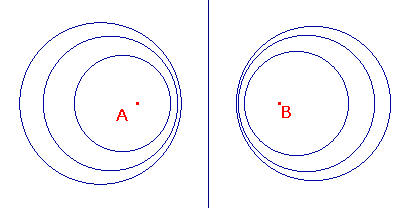- Ak(A,B) is a line if k is 1, and a circle if k is not 1.
- If Ak(A,B) is the circle C with centre C and radius r, then
- A, B and C are collinear, with A and B on the same side of C, and
- CA.CB = r2.
- If A, B, and the circle C satisfy (1) and (2), then C, is in A(A,B).

We choose the perpendicular bisector of AB as the y-axis,
and the line AB as the x-axis, so if A is (a,0), then B is (-a,0).
Then P(x,y) lies on Ak(A,B) if and only if
PA = k.PB.
Squaring, we get
(x-a)2 + y2 = k2{(x+a)2 + y2 }.
Rearranging, we have (k2-1)(x2 + y2 + a2) + 2a(k2 +1)x = 0.
If k = 1, this gives the line x = 0 (the perpendicular bisector of AB).
Otherwise, we can divide by (k2 -1) to get the circle
For brevity, put K = (k2+1)/((k2-1). As k > 0, |K| > 1.
Completing the square and simplifying, C has equation
Thus, C lies on the x-axis, i.e. on AB, and, as |K| > 1, lies outside [A,B].
Also CA.CB = (a-aK)(-a-aK)=a2(K2-1) = r2.
This proves the second part.
Finally, suppose that A, B and the circle C
satisfy (1) and (2).
As A, B and C are collinear, C lies on the x-axis, so is (aK,0), for some K.
As A and B lie on the same side of C, |K| > 1.
Thus C has equation (x-aK)2 + y2 = r2.
Also, by (2), r2 = CA.CB , so r2 =(a-aK).(-a-aK) = a2(K2-1).
Combining these, C has equation x2 + y2 -2aKx + a2 = 0.
Using the equation for Ak(A,B) found in the first part,
C is in A(A,B) if and only if K = (k2+1)/(k2-1),
i.e. k2 = (K+1)/(K-1).
The left side is positive as |K| > 1, so k exists.